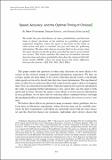| dc.contributor.author | Fudenberg, Drew | |
| dc.contributor.author | Strack, Philipp | |
| dc.contributor.author | Strzalecki, Tomasz | |
| dc.date.accessioned | 2021-10-27T20:09:51Z | |
| dc.date.available | 2021-10-27T20:09:51Z | |
| dc.date.issued | 2018 | |
| dc.identifier.uri | https://hdl.handle.net/1721.1/134916 | |
| dc.description.abstract | © 2018 American Economic Association. We model the joint distribution of choice probabilities and decision times in binary decisions as the solution to a problem of optimal sequential sampling, where the agent is uncertain of the utility of each action and pays a constant cost per unit time for gathering information. We show that choices are more likely to be correct when the agent chooses to decide quickly, provided the agent's prior beliefs are correct. This better matches the observed correlation between decision time and choice probability than does the classical drift-diffusion model (DDM), where the agent knows the utility difference between the choices. | |
| dc.language.iso | en | |
| dc.publisher | American Economic Association | |
| dc.relation.isversionof | 10.1257/AER.20150742 | |
| dc.rights | Article is made available in accordance with the publisher's policy and may be subject to US copyright law. Please refer to the publisher's site for terms of use. | |
| dc.source | American Economic Association | |
| dc.title | Speed, Accuracy, and the Optimal Timing of Choices | |
| dc.type | Article | |
| dc.contributor.department | Massachusetts Institute of Technology. Department of Economics | |
| dc.relation.journal | American Economic Review | |
| dc.eprint.version | Final published version | |
| dc.type.uri | http://purl.org/eprint/type/JournalArticle | |
| eprint.status | http://purl.org/eprint/status/PeerReviewed | |
| dc.date.updated | 2019-10-22T18:27:52Z | |
| dspace.orderedauthors | Fudenberg, D; Strack, P; Strzalecki, T | |
| dspace.date.submission | 2019-10-22T18:27:54Z | |
| mit.journal.volume | 108 | |
| mit.journal.issue | 12 | |
| mit.metadata.status | Authority Work and Publication Information Needed | |
